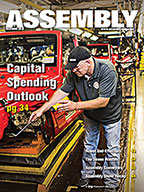One year ago we noted that despite rhetoric about a "jobless recovery," the available data showed that as the United States emerged from recession, the economy was also moving-albeit slowly-toward recovering jobs. This was confirmed by 2004's ninth annual ASSEMBLY State of the Profession survey, when 30 percent of respondents said they had added staff to their assembly operations.
Today, the challenge of hiring and keeping good employees has never been greater. The National Association of Manufacturers (NAM, Washington) says that one of the most protracted problems that manufacturers face is the lack of new skilled workers to operate their plants. Five years ago, in the NAM's first study on the workplace, 80 percent of manufacturers reported a shortage of qualified job candidates. This shortage still exists for both large and small companies, and the more pervasive problem now is the need for production workers, machinists and craft workers skilled enough to work in the manufacturing jobs of the 21st century.
The most recent employment outlook survey by Manpower Inc. (Milwaukee) predicts that hiring activity by U.S. employers will continue strong into the second quarter. Durable goods manufacturers continue to envision better year-over-year hiring, and nondurable goods manufacturers expect to be hiring as they have been.
At the same time, it is interesting to note that the number of older Americans in the workforce has been increasing steadily over the past 15 years, after decreasing for decades. Largely due to changes in retirement laws, living longer and increasing financial pressure, workers aged 50 and over are staying in-or returning to-the workforce long past traditional retirement age.
For example, Arline Ruhs is on the job at Oconomowoc Manufacturing Co. (Oconomowoc, WI) every day at 4:30 a.m. Ruhs, now 85, has been on the job there for more than 35 years making ball bearings, according to Joel Dresang, writing in the Milwaukee Journal Sentinal. The plant has automated machines that make bearings faster and are useful for high-volume orders. But Kyle Stoehr, president of Oconomowoc, says the company has survived by focusing on customization and quality, which are served by manual machine operators like Ruhs.
The graying of the workforce is not confined to the shop floor. Cutbacks, outsourcing and people starting their own small companies may also precipitate a shortage of managers for American companies over the next decade, according to a survey by Novations Group (Boston).
So in the years ahead, younger managers will increasingly be responsible for senior employees on the shop floor (Ruhs had been working at Oconomowoc 5 years when Stoehr was born) and older managers will increasingly be mentoring younger workers as they begin their careers. If both groups focus on blending their experience and enthusiasm, they and American manufacturing will succeed together.

